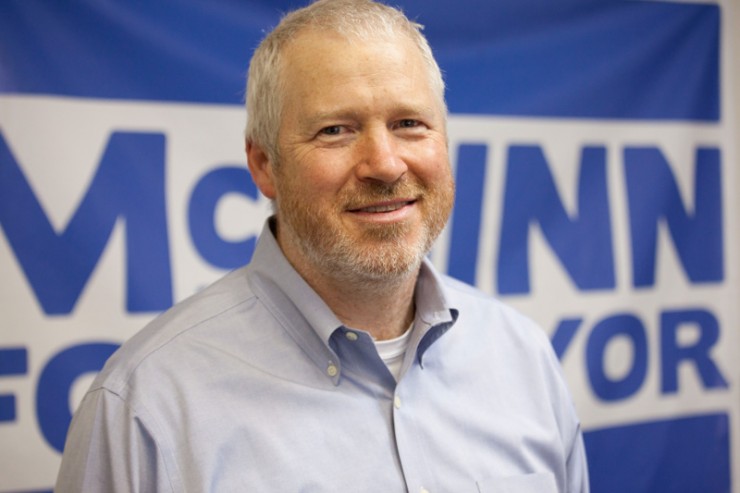
Former Seattle Mayor Mike McGinn. Photo by David Ryder.
Bikelash is a clever term that describes the hand-wringing cries of, “War On Cars!†that’s followed the installation of every inch of bike infrastructure in the US. Even in the bikiest cities such as Portland, Seattle, Minneapolis, and New York, new bike lanes are met with fear and anger. And though bike politics may always be divisive to some degree, in Seattle it felt like bikelash reached its virulent fever pitch during former Seattle Mayor Mike McGinn’s term in office.
The mayor himself was a bikelash lightening rod. He aligned closely with biking and walking advocates during his campaign and his term (his team even handed out “Mike Bikes†stickers and spoke cards during his first campaign). He fought against a multi-billion dollar project to build a highway under Seattle. And he implemented highly visible arterial “road diet†projects that prioritized biking and walking safety over speed by reducing the number of car lanes. In return, the media, political opponents, and the public dismissed him as anti-car, out of touch, the biking mayor, and, my favorite of the bunch, Mayor McSchwinn. I sat down with McGinn near his home in north Seattle to talk about his experience with bikelash, dealing with divisive bike politics as mayor, the role of mayors in transforming streets, how advocates can assist electeds in their job, and much more.
Though you were known as the bicycle mayor, you’re a relative latecomer to bike commuting. What inspired you to start riding around town?
Yes and no. Like everybody, I have great childhood memories of cruising around. We lived on a dead end street on suburban Long Island so there was lots of biking in the road. I remember my first bike was a three-speed Rudge. That was cool, it was a grown up bike. My first bike commuting was to Catholic high school a few towns away. It was three or four miles and took two buses. I saved up money from a summer job and went into New York City and bought an Atala 10 speed. I think I was 15 years old at the time.
Eventually I dropped biking. But when I was 29 I came out here to go to law school at the University of Washington. I bought a bike at a garage sale and started commuting from my rental house to campus to the IMA to play basketball then home. I guess I dropped it again for a while. Then when I was working downtown and commuting home to Greenwood I went to Recycled Cycles and bought a used Trek. I would take the bus in in my work clothes then bike home. Part of why I started riding was I’d gotten really bad plantar faciitis in my feet playing basketball and I couldn’t play anymore or run. I figured I’d better start getting some exercise and bikes seemed like a way to do it.
How’d you get to the point of riding nearly all the time?
I was maybe riding one or two round trips a week then. [Seattle City Councilman] Mike O’Brien was the Chief Financial Officer at the law firm I worked at and he put together a team for Bike to Work month. I’m competitive so I tried to bike both ways every day. That was the start of my regular commuting.
A few years later I was starting my nonprofit Great City and I wasn’t making much money. In fact I wasn’t making money at all the first year so we decided to get rid of the second car. I made a commitment then that I would bike all the time. And I stuck with it. I really like it for a number of reasons. It gets you outside, which is nice even if it’s kinda crappy out. You get your exercise in without having to schedule it so to speak. It’s just part of your day. And it saves money.
Do you have a favorite place to ride around the Seattle area?
You know, it’s funny, I don’t really bike for pleasure. I bike for mobility. There’s lots of rides I like, but when I was commuting back and forth every day, the last thing I wanted to do on the weekend was get on a bike. I love going down Phinney Ridge though. It’s relatively flat, you’ve already gotten to the top of Fremont Hill and I’m on my way home. You look to your left and you see the Olympics. You look to your right and you can see the Cascades.
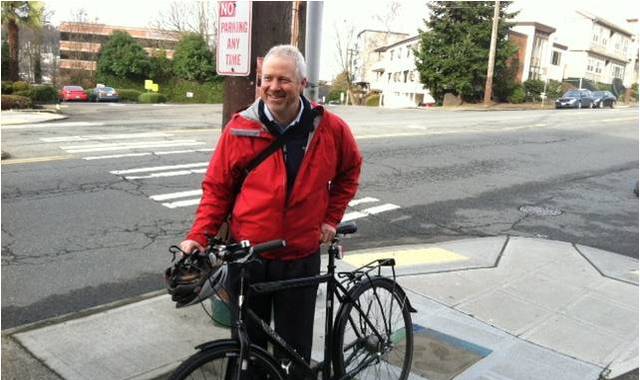
Photo by Alyssa Kleven via mynorthwest.com.
Not that new bike infrastructure ever comes without a fight, but bike politics in Seattle were particularly divisive while you were in office. Or at least it was portrayed that way in the media. Why do you think bikes turned into such a hot topic?
It is controversial. I decided to actually implement the Bike Master Plan. I noticed when I took office … actually I should really start before that. In my nonprofit, neighborhood activism, and through the Sierra Club, we were pushing the city for change. It was clearly controversial before me. Mayor [Greg] Nickels had the city’s first Bike Master Plan. I think he had it in part because we had all let him know what a mistake it was to redo the Westlake Ave parking lot and sidewalk without accommodating bicycles. There’d been representations that it would be a bike trail. It’s kind of ancient history; this is not the current Westlake discussion. There was still a railroad right of way running down Westlake that had been relinquished. There was this huge opportunity. We thought, “Oh great, we’ll get this and have a bike path to downtown.†Instead, they rebuilt 1,600 parking spaces and there was nothing there really for bikes. The [Cascade] bike club and I continually raised it and I think Mayor Nickels recognized it as a missed opportunity. This was relatively early in his term and he came back with a Bike Master Plan, which was great.
The next big thing that came around was Stone Way. At the time it was two lanes each way and an unsafe street. There was a proposal to rechanelize it. It was really controversial. The bike club was out there protesting every day for a while under [David] Hiller’s advocacy leadership. The city finally relented and put in the bike lanes there. Then we didn’t really see many bike projects after. I think it was so hot and Greg was coming around for re-election, so when I took office there were a whole bunch of projects lined up.
I met with SDOT and they had a bunch of projects ready to go. I was like, “OK, let’s go. Let’s do Nickerson. Let’s do 125th. Let’s do the projects on the books.” I learned quickly that there’s a lot of fear from the driving public that their commute will get harder. You know, driving does stink. It’s no fun to drive around town when it’s congested and a lot of members of the driving public believed that those rechannelizations would cause more congestion. They don’t. The data’s there that they don’t. But it’s really hard to convince people of that who feel strongly about it.
Why did you push hard for implementing the Bike Master Plan?
I was always motivated by the issue of safety. I live a couple of blocks north of 85th and right here on 85th a young man was rushing to cross the street. Traffic stopped. The car in the curb lane stopped. The car following that car swerved into the center lane and hit the kid and now he’s brain damaged for life. Around the same time, right over here on Crown Hill where Holman Road curves into 15th, there was a 10 year old boy who was coming home from school and the car in the curb lane stopped, he decided to go across, and the mirror of a pick-up truck in the center lane hit him in the head and he’s permanently brain damaged and in a wheel chair now. 125th and Nickerson are both great examples. They weren’t actually about bike lanes. They were about the fact that these were unsafe streets to cross. The way to make them safe for pedestrians was to rechannelize them so you only have one lane of cars going each way; you have the center lane for some refuge. The bikes lanes on either side plus a center turn lane have a traffic calming effect and the speeds come down. For me, the safety trumped everything. But it was portrayed by media as, “McGinn the biker pursuing his pet bike projects†and, “he hates cars.†That was a very short sighted and callous approach by the media who couldn’t get past their own point of view from behind their steering wheel and think of the kids crossing the street. It was a way for them to demean and trivialize my position in order to defend the status quo.
It’s weird. You would think that safety piece would universally resonate. People have families, people have children. But there’s some disconnect between the message of “this is infrastructure for bikes†and “this is infrastructure that makes streets safer.â€
They just don’t believe it. People don’t realize it’s the road design itself that dictates the speed drivers go. That happens to the most conscientious drivers. When you’re on that street with two lanes in each way, it’s wide open, you just have a feeling that you can go faster and it’ll be safe. It’s a very false sense of safety. There are potentially bikers and pedestrians present, but you’re now likely to ignore them and you’re going at speeds that are deadly if you have a collision.
Lake City was one of the least safe streets in the entire city. The police would go down there because they knew they could hand out speeding tickets at will. Whenever the Speed Unit wanted to show it was working to catch speeders they went there. We were up there presenting about a Lake City safety project. There are 200 people in a meeting room and I’m just getting the hell beat out of me. [Former SDOT Director] Peter Hahn is with me and Peter tried to explain to them that, “no this is going to work just fine. We’ve done 28 or 29 of these in the city and in each case the traffic congestions does not materialize.” I think the analogy he was using was something like, “look you don’t need a two gallon jug to carry a gallon of water. We don’t need this big a street.” And people were saying, “but our street is really unique.” Peter was like, “we know what’s going to happen. If you go to McDonalds all the time, I don’t need to study one McDonalds to know you’re going to gain weight.” That really set everyone in the room off.
It’s always really hot. And it was really bad because the media was fully participating in the story. There was the day that Michael Wang was killed on Dexter. He was a PATH employee and a photographer in his spare time. He was biking home to see his wife and kids for dinner. He was in the bike lane and a car coming the opposite direction took a left turn and hit him. It was a hit and run. I don’t believe they’ve ever found the driver. [Eds. note: they did catch the driver.]
That evening I was at an event about parks in West Seattle and a reporter came up to me with a TV camera and asked me how I felt about this. Of course I said this is tragic and I feel terrible and my sympathies are with Wang’s family. And his next question for me was, “what are you going to do about all the bicyclist running red lights?” I kept my cool because I was on camera. When he turned it off I said, “Michael Wang was going home to see his family. What the hell does that have to do with anything?” I was really angry. It was at that point that I resolved to do what I could to try to change the debate and we launched our road safety summit.
Tell me more about the road safety summit.
We went to every neighborhood, invited everyone in, and made them sit at tables together–bikers and industry folks and drivers and seniors and walkers and bus users. We said let’s just have a dialogue about what the hell’s going on and how can we make this work? Those unsafe roads aren’t just killing walkers and bikers. They’re killing drivers too. We have about as many people die in our streets each year from automobile collisions as we do from murders. If there’s murder or a series of murders there are calls for us to do something. Yet somehow we treat these deaths from automobile collisions as the price of a motoring society. Or the fault of the biker or pedestrian or driver. Not the fault of road design and a system that prioritizes mobility over someone getting home to see his family for dinner.
We came up with our road safety action plan and called it Be Super Safe. We thought about naming it something like Vision Zero, but I didn’t like that. But it was the same goal: Let’s get to zero fatalities. I know New York City’s getting all the press for that with DeBlasio and Vision Zero, but we had it here first. And it really helped change the debate. And the other big thing that helped was that we saw the Neighborhood Greenways folks and others really starting to enter the debate and trying to change it to say this is about communities and families and having safe places. Cathy Tuttle would organize a memorial walk after every death and bring the community together. That was really big too and people were starting to say, “this is an entirely unproductive debate.”
What bike accomplishment are you most proud of from your time in office?
I have a theory that every city that decides to do biking seriously has to kind of go through a passage where everyone just loses it. Then once you get through that and you actually start implementing projects and everyone has the opportunity to have their say, you get to the other side. And we’re at the other side now. We’re doing dedicated cycle tracks. We did the first couple in Bitter Lake Urban Village, Broadway, and now that’s what we’re doing downown. We established that pathway, and now I don’t think we’re going to get knocked off it. I saw when I took office that electeds were prepared to do symbolic things on behalf of bicycling, but they were leery of the backlash that would occur when they did it.
Advocates often talk about the role of mayors in advancing biking, walking and street safety efforts. How much power do mayors wield in transforming city streets?
There’s a tremendous amount of power. Cities own local streets. It’s one of the places you’re going to have the biggest impact. There are a lot of things we don’t really control, but we control what our street looks like. Period. Mayors have a choice about whether they’re going to be anchored in the past or they’re going to prepare for the future.
People still like to come up to me and talk to me about biking. A nice guy came up to me recently and said, “well, I don’t really support you, I’m a Republican and I don’t like that biking stuff.” I said, “hey, you should love the biking stuff. The marketplace has spoken. People want to bike. We’re just responding to the demand that’s ready and waiting for this as soon as we supply it. People are voting with their feet. You should love it!” He had to smile when I said that. It’s the truth. People really want it. And it’s really great for the economic health and vitality of places that make these changes. It makes them more desirable.
What could bike advocates have done differently when you were in office that would’ve made it easier to get bike projects done? How can bike advocates help electeds?
I mentioned one that the neighborhood greenways movement did and Cathy Tuttle in particular, which is highlighting safety. That was huge. The other thing that started happening was that people started coming to the town halls to present the other side. It’s not just with biking. Sometimes when there’s someone in office you think is on your side you think, “oh they’ve got it. I don’t have to advocate as much.”
When I’m in the front of town halls talking and everyone’s complaining about bicycles, you start getting this thing of “it’s the public trying to stop the government from doing something bad to them.” If there’s someone at that town hall saying, “thank you for the bike lanes” or, “I support bike lanes,” now it’s neighbors talking to each other about what should happen in their community. People have a right to get cynical and angry at the government–there’s good reason for them to feel that way because government has let them down so many times–but people have a hard time getting cynical and angry at their neighbors. I was always prepared to stand there and take the heat for doing what was right. But showing up to the town hall and making it clear what you stand for sure brought the temperature down. When someone said, “thank you mayor for the bike lanes” or, “I like the bike lanes” or “when are we going to get bike lanes?” it adds up and changes the debate completely.
What’s next for you?
I like to say I’ve been enjoying a little sabbatical. I’ve been helping folks who ask me for help, whether it’s people working on divestment or people working on urban issues or things like that. I’ve been having a good time. I presented at the Strong Towns Conference as keynote speaker. I’ve been doing some other speaking gigs. I’ve been thinking about how to capture a few things I learned. This interview might’ve reflected a few thoughts I’ve had about what works and what doesn’t in politics. I want to figure out a way to share those lessons with people.
Like what you read on The Bicycle Story? Support the work with a donation, by buying a shirt, or sharing it with your friends.
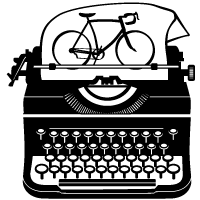
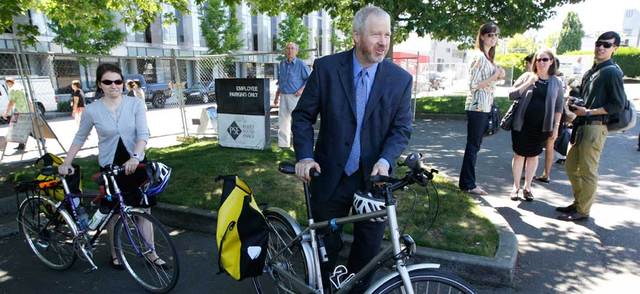
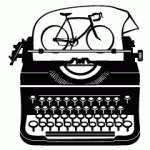
Pingback: Weekend Reading 12/5/14 | Sightline Daily